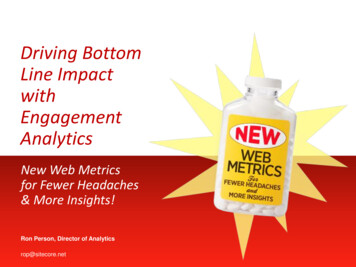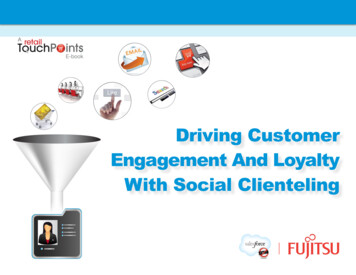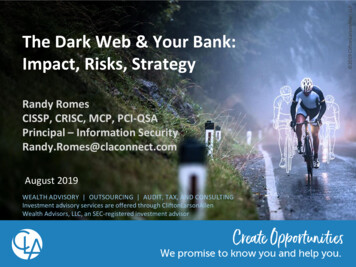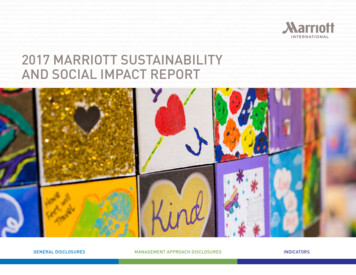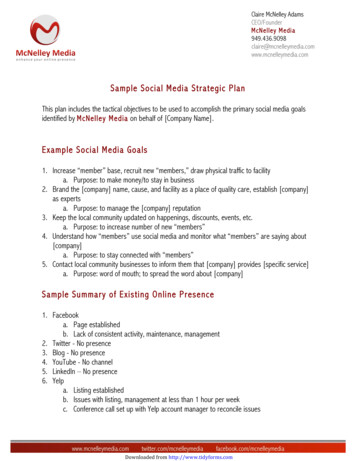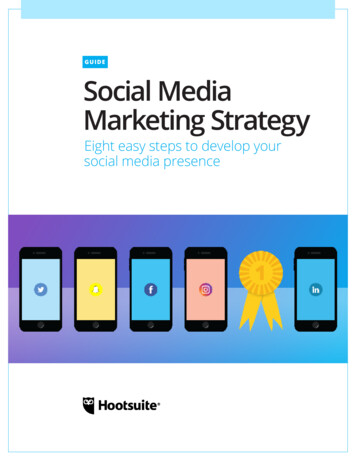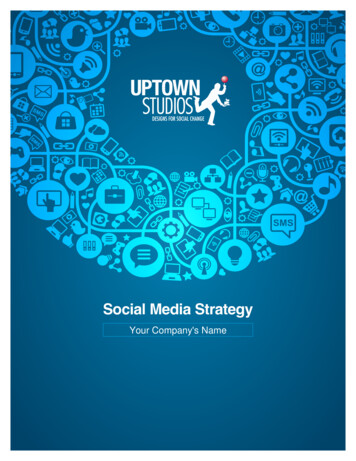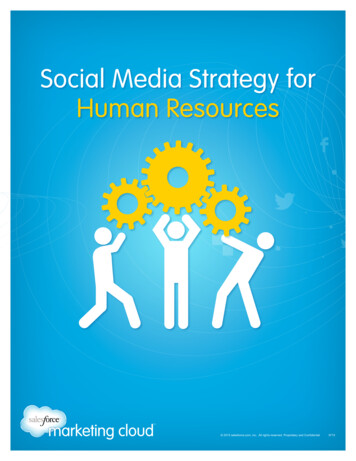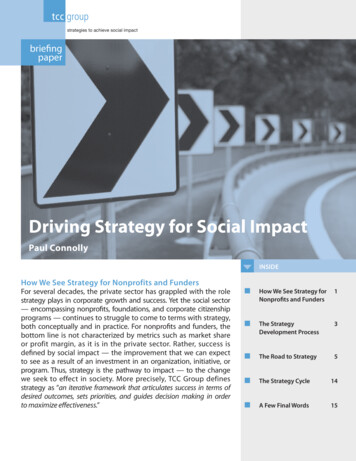
Transcription
strategies to achieve social impactbriefingpaperDriving Strategy for Social ImpactPaul ConnollyInsideHow We See Strategy for Nonprofits and FundersFor several decades, the private sector has grappled with the rolestrategy plays in corporate growth and success. Yet the social sector— encompassing nonprofits, foundations, and corporate citizenshipprograms — continues to struggle to come to terms with strategy,both conceptually and in practice. For nonprofits and funders, thebottom line is not characterized by metrics such as market shareor profit margin, as it is in the private sector. Rather, success isdefined by social impact — the improvement that we can expectto see as a result of an investment in an organization, initiative, orprogram. Thus, strategy is the pathway to impact — to the changewe seek to effect in society. More precisely, TCC Group definesstrategy as “an iterative framework that articulates success in terms ofdesired outcomes, sets priorities, and guides decision making in orderto maximize effectiveness.”How We See Strategy forNonprofits and Funders1The StrategyDevelopment Process3The Road to Strategy5The Strategy Cycle14A Few Final Words15
2briefing paperTCC GroupWe see strategy occurring at several levelsthat are at once distinct and interrelated: Organizational: For a nonprofit,foundation, or business, how issuccess defined and achieved, bothprogrammatically and in terms ofleadership and management?C P r o g r a m m a t i c :What can beaccomplished through a specificprogram or initiative?C Community-wide: How can variousactors in a community, defined by ashared geography or purpose, combineefforts to realize a larger goal?C Sectoral and System-Wide: What are themost strategic ways to address the macrolevel challenges confronting our society,and how do we work within and acrossthe nonprofit, philanthropic, public, andprivate sectors to address them?Cdefines strategyas “an iterativeframework thatarticulates successin terms of desiredoutcomes, setspriorities, andguides decisionmaking in orderto maximizeeffectiveness.”Since 1980, TCC Group has helpednonprofits, foundations, and corporatesocial responsibility programs develop,implement, assess, and refine theirstrategies. As our society has become morediverse and complex, we have seen thechallenges facing nonprofits and fundersgrow exponentially.Strategy matters, be it for a single programor across a system, because it is aboutdefining impact, clarifying priorities, andallocating resources in a systematic way— all to solve those problems that theprivate sector has not addressed. Thesmallest strategy could ultimately resultin more effective policies or responsivesystems. If implemented effectively, forexample, a program strategy couldexpand for an initiative or an organization.An individual nonprofit can magnify itsimpact by banding together in a coalitionwith a shared, coordinated approach.And a group of funders might increasetheir effectiveness by aligning strategiestowards a unified set of goals. More thanever, the work of the social sector needsto be guided by clearly defined and wellcoordinated objectives in order to meetthe growing and increasingly complexchallenges we face.Of course, the world does not usuallywork in such linear or rational ways.As an inherently iterative process,effective strategy is dynamic and flexible,providing leaders with a framework formaking decisions, solving problems, andresponding to opportunities as they arise.While strong leadership remains essentialin defining strategy, decision makersmust be thoughtful and inclusive in theirapproach, incorporating the perspectivesof numerous stakeholder groups.As the pace of change has accelerated, wehave seen the “strategy lifecycle” becomeshorter. Strategy is more important thanever and must accommodate the demandsof an arduous and rapidly shiftingenvironment, allowing for adjustmentsand refinements that are made in “realtime,” to the extent possible. It is alsoimperative that strategy for the socialsector include measurable performanceand outcomes that will facilitate learning,
briefing paperLevels of onalProgrammaticadaptability, and improvement. We can no longer assumethat a strategy is successful because it was carried out. Weneed to be able to understand whether our investmentsmade a difference, and why. Doing so, in turn, will allowfor the integration of strategies within and acrossorganizations to help define and achieve common goals.The need for strategy coordination across fields has alsobecome more urgent as the boundaries between themhave blurred, with nonprofits being more entrepreneurialand business-like and corporations becoming moresocially and environmentally responsible.The Pfizer Foundation and Pfizer Worldwide Philanthropychose to pursue a more integrated strategy focused oninvesting the full range of the company’s resources —people, skills, expertise, and funding — to broaden accessto medicines and strengthen healthcare delivery forunderserved people around the globe.TCC worked with Pfizer to design a program strategy toaddress the HIV/AIDS epidemic in the southern UnitedStates. Based on research on the biggest gaps in careand emerging trends, as well as extensive input fromstakeholders, Pfizer decided to focus on preventionprograms in small to mid-size AIDS service organizations,particularly those working with minorities and women.The three-year program provided more than 3 million inprogram investments and 3 million in capacity-buildingopportunities to 23 grantees. The Pfizer Foundation also3introduced Pfizer Inc’s HIV Community Liaisons (HCLs) tothe grantee partners so they could foster more localizedrelationships with Pfizer Inc. and access local resources,such as training materials, sponsorships, and volunteers.Increasingly, nonprofits acknowledge that working acrossorganizations is integral to achieving impact. Coalitionsalso require strategy, and members need to be clear aboutways to coordinate their individual and collective goalsand strategies. As Sue Hoechstetter of the Alliancefor Justice observed, “When I represented the NationalAssociation of Social Workers (NASW) in the Coalitionfor Human Needs, there were times when a legislativeproposal would increase government funding for neededservices (an NASW goal), and, at the same time, createproblems for social workers’ (our members) ability toprovide those services.” She continued, “Sometimes, wehad to temporarily focus on fixing the problem criticalto our members, while other coalition members ‘carriedthe water’ on pushing forward the bigger legislativeproposal for increased funding. The Coalition openlyrecognized when members needed to pull away froma certain strategy or activity, making it easier for groups tostay engaged in the bigger campaign.”The Strategy Development ProcessSocial sector strategy has three core components:mission statement, program strategy, and operationalplan. The mission statement is an articulation of ultimateimpact — the problem to be solved and the change tobe effected. For some organizations or initiatives, themission statement might be very clearly prescribed andeminently achievable, such as raising awareness of ansocial issue. For others, it might be much more broad,often too big to be achieved by any single initiative ororganization, such as ending homelessness or preventinggenocide. Regardless of scale, a strategy must startwith measures of success clearly articulated, so that allstakeholders understand the desired results.Program strategy outlines the way in which mission isrealized. If mission is the destination and programs arethe vehicle, then program strategy is the guide. It explainsboth the results the stakeholders will hold themselvesaccountable for achieving and the activities they will conductto reach those outcomes. Operational strategy identifiesthe basic assumptions about the type of infrastructure,
4briefing paperresources, and systems neededto support strong programsand details specific priorities forthe short- and mid-term.While this might seemstraightforward, consensuson strategy is only achievedfollowing a great deal of hardwork and discussion. Whethera three-year program initiative,a strategic plan, or a majormulti-sector systems changecollaborative, a strategy needsto be the product of an inclusiveand participatory processthat incorporates multipleperspectives, including notonly those who are responsiblefor implementing the strategy,but also those who stand tobenefit from it.Change is animplicit partof the strategyprocess, andchange isnot easy.Strategy development is an opportunityto question assumptions and stretchconventional thinking. An inclusive processimplies that there is a diversity of perspective.It is critical that leaders appreciate thata new strategy often means chartinga different course — moving in a new, moreeffective direction. In some cases, such asthe expansion of a successful pilot, this canbe a positive and exciting experience. Butat other times, a new strategy can refutea leader’s vision or direction. Most often, anew strategy is something in between — arecognition that there are both strengthsto build upon and significant changes thatneed to be made. The point is that change isan implicit part of the strategy process, andchange is not easy. Before embarking onthe development of a new strategy, leadersneed to engage in candid conversations,be willing to have their ideas challenged,and be open to feedback about what isworking well, and what is not.It is crucial to get input from a range ofconstituents as decisions are made alongthe way. Without that buy-in, it is difficultto garner support further down theroad. For instance, Habitat for HumanityInternational’s New York City affiliaterecognized this when it successfullydesigned a highly participatory strategicplanning process that TCC facilitated andwhich incorporated the perspective of over100 stakeholders. The organization was ableto clarify its future vision and set priorities ata large retreat, which laid the groundwork forcreating a detailed organizational strategy.That plan led to such positive results asincreased revenue through a corporategiving program, an annual gala, and thelaunch of a new program area — advocacy— which engaged over 100 faith institutions.It also served as a vital framework for staffand board decision-making.Former Executive Director Roland Lewisobserved that “the plan was owned andused by staff and board alike becausestakeholders were brought into the processand remained engaged.” Lewis recalled aboard meeting in which a board memberquestioned the organization’s emphasison advocacy work. In response, anothermember immediately pointed to thesection of the plan that reinforced advocacyas an organizational priority, moving themeeting’s focus back on track.The breadth and depth of the datacollection as well as the methodologyused will vary by organization. The key isstriking a balance between ensuring thatthe right people are given the opportunityto provide input and doing so in the mostcost-effective manner. To achieve thisbalance, it is important to understandwhich staff members need to provideinput and what is the best way to engagethem. This clarity will allow for the creation
briefing paper5of an effective data collection strategy that combinessurveys, site visits and observation, interviews, anddiscussion groups, while reaching all crucial stakeholders.be held accountable for implementation of strategy. Fora coalition, the committee would likely be composed ofrepresentatives of the various member groups.While a participatory process is important, incorporatingthe full range of perspectives does not mean soliciting allopinions; everyone’s vote is not equal. A strategy processneeds to be guided by a planning committee that hassufficient knowledge and authority to make key decisionsbased on good information. To do so, the committee needsto include the right mix of decision makers.Whomever the members are, what is most important is thatthe group collectively have the confidence of the largerentity — be it a company, a nonprofit, a foundation, or acollaborative — so it can consider the information at handand use the data to make decisions about future direction.For a corporate community involvement program,decision makers might include representatives ofdepartments who must engage key stakeholders, suchas community relations, marketing, and human resourcesstaff. For a nonprofit organization or foundation, thecommittee should be composed of board and seniorstaff, including the executives and any others who willThe Road to StrategyThe path to defining strategy is a relatively straightforwardsequence entailing steps that include:1. I dentify the Right Questions to Ask and Gatherthe Best Data2. Turn Data into Knowledge3. Turn Knowledge Into Strategy4. Make the Strategy Actionable5. Implement, Assess, and RefineStrategy Process1. Identify the Right Questions to Ask and Gather the Best DataCUnderstand the needsCFrame the issuesCIdentify critical questions Conduct organizational assessments, financial trend analysis, program audits, market research, competitive analysis, and benchmarkingC2. Turn Data into KnowledgeCInterpret the dataCPrioritize findings3. Turn Knowledge into StrategyCShare the findings with leaders Facilitate development of desired outcomes and program strategies that build on findings using tools such as logic modelsCand scenarios4. Make the Strategy ActionableC Convene stakeholders to determine priorities, goals, and objectivesC Help to determine the organizational capacity needed to support program strategyCDraft the plan with clear benchmarks of success5. Implement, Assess, and RefineCCoach leaders on implementationCEvaluate the success of the plan
6briefing paper1. Identify the RightQuestions to Ask andGather the Best DataThe importance of thisfirst phase is oftenunderesti
mission statement, program strategy, and operational plan. The mission statement is an articulation of ultimate impact — the problem to be solved and the change to be effected. For some organizations or initiatives, the mission statement might be very clearly prescribed and eminently achievable, such as raising awareness of an

